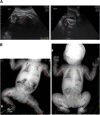Pre- and postnatal transplantation of fetal mesenchymal stem cells in osteogenesis imperfecta: a two-center experience
- PMID: 24342908
- PMCID: PMC3925052
- DOI: 10.5966/sctm.2013-0090
Pre- and postnatal transplantation of fetal mesenchymal stem cells in osteogenesis imperfecta: a two-center experience
Abstract
Osteogenesis imperfecta (OI) can be recognized prenatally with ultrasound. Transplantation of mesenchymal stem cells (MSCs) has the potential to ameliorate skeletal damage. We report the clinical course of two patients with OI who received prenatal human fetal MSC (hfMSC) transplantation and postnatal boosting with same-donor MSCs. We have previously reported on prenatal transplantation for OI type III. This patient was retransplanted with 2.8 × 10(6) same-donor MSCs per kilogram at 8 years of age, resulting in low-level engraftment in bone and improved linear growth, mobility, and fracture incidence. An infant with an identical mutation who did not receive MSC therapy succumbed at 5 months despite postnatal bisphosphonate therapy. A second fetus with OI type IV was also transplanted with 30 × 10(6) hfMSCs per kilogram at 31 weeks of gestation and did not suffer any new fractures for the remainder of the pregnancy or during infancy. The patient followed her normal growth velocity until 13 months of age, at which time longitudinal length plateaued. A postnatal infusion of 10 × 10(6) MSCs per kilogram from the same donor was performed at 19 months of age, resulting in resumption of her growth trajectory. Neither patient demonstrated alloreactivity toward the donor hfMSCs or manifested any evidence of toxicities after transplantation. Our findings suggest that prenatal transplantation of allogeneic hfMSCs in OI appears safe and is of likely clinical benefit and that retransplantation with same-donor cells is feasible. However, the limited experience to date means that it is not possible to be conclusive and that further studies are required.
Keywords: Cell therapy; In utero transplantation; Mesenchymal stem cells; Mesenchymal stromal cells; Osteogenesis imperfecta; Prenatal transplantation.
Figures





Similar articles
-
An exploratory open-label multicentre phase I/II trial evaluating the safety and efficacy of postnatal or prenatal and postnatal administration of allogeneic expanded fetal mesenchymal stem cells for the treatment of severe osteogenesis imperfecta in infants and fetuses: the BOOSTB4 trial protocol.BMJ Open. 2024 Jun 4;14(6):e079767. doi: 10.1136/bmjopen-2023-079767. BMJ Open. 2024. PMID: 38834319 Free PMC article.
-
Prenatal transplantation of mesenchymal stem cells to treat osteogenesis imperfecta.Front Pharmacol. 2014 Oct 9;5:223. doi: 10.3389/fphar.2014.00223. eCollection 2014. Front Pharmacol. 2014. PMID: 25346689 Free PMC article.
-
Stakeholder views and attitudes towards prenatal and postnatal transplantation of fetal mesenchymal stem cells to treat Osteogenesis Imperfecta.Eur J Hum Genet. 2019 Aug;27(8):1244-1253. doi: 10.1038/s41431-019-0387-4. Epub 2019 Mar 27. Eur J Hum Genet. 2019. PMID: 30918362 Free PMC article. Clinical Trial.
-
Stem cell transplantation before birth - a realistic option for treatment of osteogenesis imperfecta?Prenat Diagn. 2015 Sep;35(9):827-32. doi: 10.1002/pd.4611. Epub 2015 Jun 3. Prenat Diagn. 2015. PMID: 25962526 Review.
-
In utero stem cell transplantation for radical treatment of osteogenesis imperfecta: perspectives and controversies.Am J Perinatol. 2014 Nov;31(10):829-36. doi: 10.1055/s-0033-1363501. Epub 2013 Dec 17. Am J Perinatol. 2014. PMID: 24347264 Review.
Cited by
-
In Utero Cell Treatment of Hemophilia A Mice via Human Amniotic Fluid Mesenchymal Stromal Cell Engraftment.Int J Mol Sci. 2023 Nov 16;24(22):16411. doi: 10.3390/ijms242216411. Int J Mol Sci. 2023. PMID: 38003601 Free PMC article.
-
Bone repair with skeletal stem cells: rationale, progress to date and clinical application.Ther Adv Musculoskelet Dis. 2016 Jun;8(3):57-71. doi: 10.1177/1759720X16642372. Epub 2016 Apr 1. Ther Adv Musculoskelet Dis. 2016. PMID: 27247633 Free PMC article. Review.
-
In utero therapy for congenital disorders using amniotic fluid stem cells.Front Pharmacol. 2014 Dec 19;5:270. doi: 10.3389/fphar.2014.00270. eCollection 2014. Front Pharmacol. 2014. PMID: 25566071 Free PMC article.
-
Fetal Treatment 2017: The Evolution of Fetal Therapy Centers - A Joint Opinion from the International Fetal Medicine and Surgical Society (IFMSS) and the North American Fetal Therapy Network (NAFTNet).Fetal Diagn Ther. 2017;42(4):241-248. doi: 10.1159/000475929. Epub 2017 May 23. Fetal Diagn Ther. 2017. PMID: 28531885 Free PMC article. Review.
-
In utero Therapy for the Treatment of Sickle Cell Disease: Taking Advantage of the Fetal Immune System.Front Cell Dev Biol. 2021 Jan 22;8:624477. doi: 10.3389/fcell.2020.624477. eCollection 2020. Front Cell Dev Biol. 2021. PMID: 33553164 Free PMC article. Review.
References
-
- Steiner RD, Pepin MG, Byers PH. Osteogenesis Imperfecta. In: Pagon RA, Bird TD, Dolan CR et al., eds. GeneReviews. Seattle, WA: University of Washington, Seattle, 1993.
-
- Glorieux FH, Bishop NJ, Plotkin H, et al. Cyclic administration of pamidronate in children with severe osteogenesis imperfecta. N Engl J Med. 1998;339:947–952. - PubMed
-
- Bishop N. Characterising and treating osteogenesis imperfecta. Early Hum Dev. 2010;86:743–746. - PubMed
-
- Pittenger MF, Mackay AM, Beck SC, et al. Multilineage potential of adult human mesenchymal stem cells. Science. 1999;284:143–147. - PubMed
Publication types
MeSH terms
Substances
Supplementary concepts
LinkOut - more resources
Full Text Sources
Other Literature Sources
Medical

